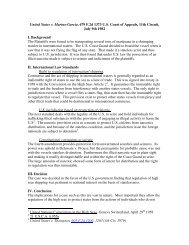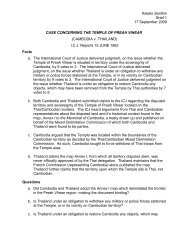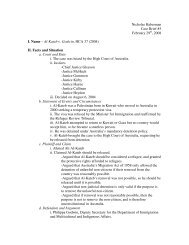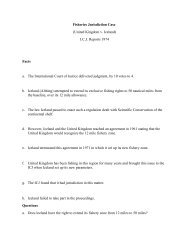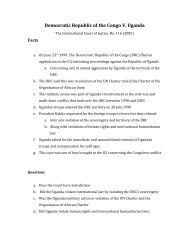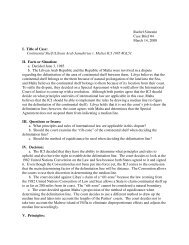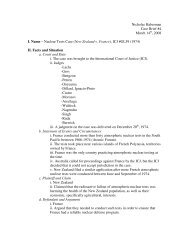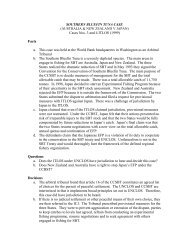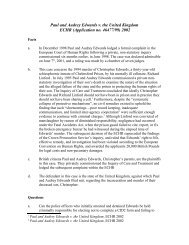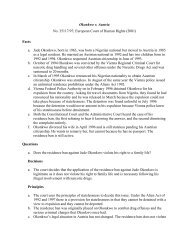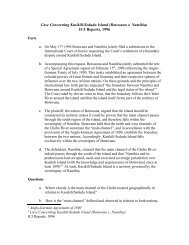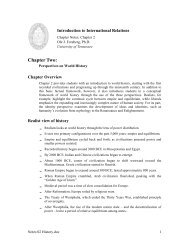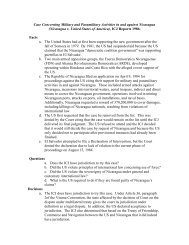United States of America v. Alstoetter et al. (âThe Justice ... - Courses
United States of America v. Alstoetter et al. (âThe Justice ... - Courses
United States of America v. Alstoetter et al. (âThe Justice ... - Courses
- No tags were found...
You also want an ePaper? Increase the reach of your titles
YUMPU automatically turns print PDFs into web optimized ePapers that Google loves.
Nicholas HabermanCase Brief #5April 3 rd , 2008I. Name – <strong>United</strong> <strong>States</strong> <strong>of</strong> <strong>America</strong> v. <strong>Alsto<strong>et</strong>ter</strong> <strong>et</strong> <strong>al</strong>. (“The <strong>Justice</strong> Cases”) (1947)II. Facts and Situationa. Court and Datei. The case was brought to US Military courts.ii. Also known as the “Tri<strong>al</strong> <strong>of</strong> War Crimin<strong>al</strong>s before the NurembergMilitary Tribun<strong>al</strong>s.”iii. Judges-C. Marsh<strong>al</strong>l-J. Brand-M. Blair-J. Hardingiv. A judgment on the case was delivered on December 3 rd and 4 th , 1947.b. Statement <strong>of</strong> Events and Circumstancesi. During World War II, many German judges began enforcing lawsfollowing the Nazi party’s ideology.ii. They approved <strong>of</strong> raci<strong>al</strong> cleansing by <strong>al</strong>lowing eugenic and persecutionprograms.iii. They <strong>al</strong>so upheld laws that would ‘preserve’ the purity <strong>of</strong> Germanblood by forbidding sexu<strong>al</strong> intercourse with Jews.iv. The judges did not resist the “Nazification” <strong>of</strong> German law.v. Consequently, this made the mass murder <strong>of</strong> millions <strong>of</strong> innocentpeople leg<strong>al</strong> according to the domestic laws <strong>of</strong> Germany.c. Plaintiff and Claimi. <strong>United</strong> <strong>States</strong> <strong>of</strong> <strong>America</strong>ii. Claim the judges committed the following four crimes:-Conspiring to commit war crimes and crimes against humanity.-War crimes through the abuse <strong>of</strong> the domestic judici<strong>al</strong> process.-Crimes against humanity.-Membership in a crimin<strong>al</strong> organization.d. Defendant and Argumenti. Josef <strong>Alsto<strong>et</strong>ter</strong> <strong>et</strong> <strong>al</strong>.ii. The defense argued the following:-Nullum crimen sine lege- that no crime may be committed withoutit being a law, say that they were performing German law.-Ex post facto principle - Argue that the violations occurred befor<strong>et</strong>he 1945 articles were created and therefore may not be imposed.-Argue that they were just complying with German law underHitler and the Nazi regime.III. Questions or Issues in the Casea. Were the defendants complying with domestic law?
3victim, or any other connection to the state exercising such jurisdiction”(Slomanson, 245).ii. The overriding nature <strong>of</strong> “the big three crimes” according tointernation<strong>al</strong> law.b. Most Important Rule Illustrated in Casei. The most important rule demonstrated by the case is that, <strong>al</strong>thoughinternation<strong>al</strong> law was not designed to directly interfere with thedomestic laws <strong>of</strong> a State, committing any one <strong>of</strong> the three “big crimes”against internation<strong>al</strong> law overrides the domestic laws <strong>of</strong> any givenstate.c. Gener<strong>al</strong> Rules the Case Demonstratesi. Although som<strong>et</strong>imes thought <strong>of</strong> as two entirely separate spheres <strong>of</strong> law,the case proves that the standards <strong>of</strong> the internation<strong>al</strong> community mayhold superiority over domestic laws.ii. One <strong>of</strong> the purposes <strong>of</strong> internation<strong>al</strong> law is to regulate justice if theintegrity <strong>of</strong> basic human rights has been violated.iii. Judges and lawyers have a responsibility in monitoring the inhumanenature <strong>of</strong> laws, and their possible consequences.VI. Conclusiona. Notes and An<strong>al</strong>ysisi. This case proved that the violation <strong>of</strong> the three major crimes ininternation<strong>al</strong> law supercedes any claim, defense, or reference to thedomestic policies <strong>of</strong> a country.ii. Without this principle, new regimes could take control <strong>of</strong> a state,reorganize its laws, and then proceed to execute them ‘leg<strong>al</strong>ly’ andwithout consequence, despite the context or inhumane nature <strong>of</strong> thoselaws.b. Historic<strong>al</strong> Significancei. Brought a new found sense <strong>of</strong> responsibility for judges to ensure that thelaws <strong>of</strong> their state do not constitute any violation <strong>of</strong> internation<strong>al</strong> law,especi<strong>al</strong>ly concerning war crimes, genocide, and/or crimes againsthumanity.ii. The case decision s<strong>et</strong> the standard for the “big three crimes,” andindirect involvement despite domestic laws.iii. Resulted in the prosecution <strong>of</strong> such crimin<strong>al</strong>s as Adolf Eichmann,Slobodan Milosevic, Saddam Hussein, <strong>et</strong>c.iv. The most fundament<strong>al</strong> purpose <strong>of</strong> internation<strong>al</strong> law was ch<strong>al</strong>lenged inthe case, and prevailed in the decision that some actions, despite their‘domestic acceptance,’ constitute an act against <strong>al</strong>l mankind.
4VII. BibliographySlomanson, William R., Fundament<strong>al</strong> Perspectives on Internation<strong>al</strong> Law, 5th ed.,C<strong>al</strong>ifornia, Thomson-Wadsworth Pub., 2007.<strong>United</strong> <strong>States</strong> Holocaust Memori<strong>al</strong> Museum, “Subsequent Nuremberg Proceedings Case#3, The <strong>Justice</strong> Case,” Holocaust Encyclopedia.http://www.ushmm.org/wlc/article.php?lang=en&ModuleId=10007073<strong>United</strong> <strong>States</strong> <strong>of</strong> <strong>America</strong> v. <strong>Alsto<strong>et</strong>ter</strong> <strong>et</strong> <strong>al</strong>. (1947), “The Nuremberg Tri<strong>al</strong>s: The <strong>Justice</strong>Tri<strong>al</strong>,” U.S. Military Courts at the Nuremberg Tri<strong>al</strong>s.http://www.law.umkc.edu/faculty/projects/ftri<strong>al</strong>s/nuremberg/<strong>Alsto<strong>et</strong>ter</strong>.htm#U.S.A.%20v.%20ALSTOETTER%20ET%20AL%20(The%20<strong>Justice</strong>%20Cases)



